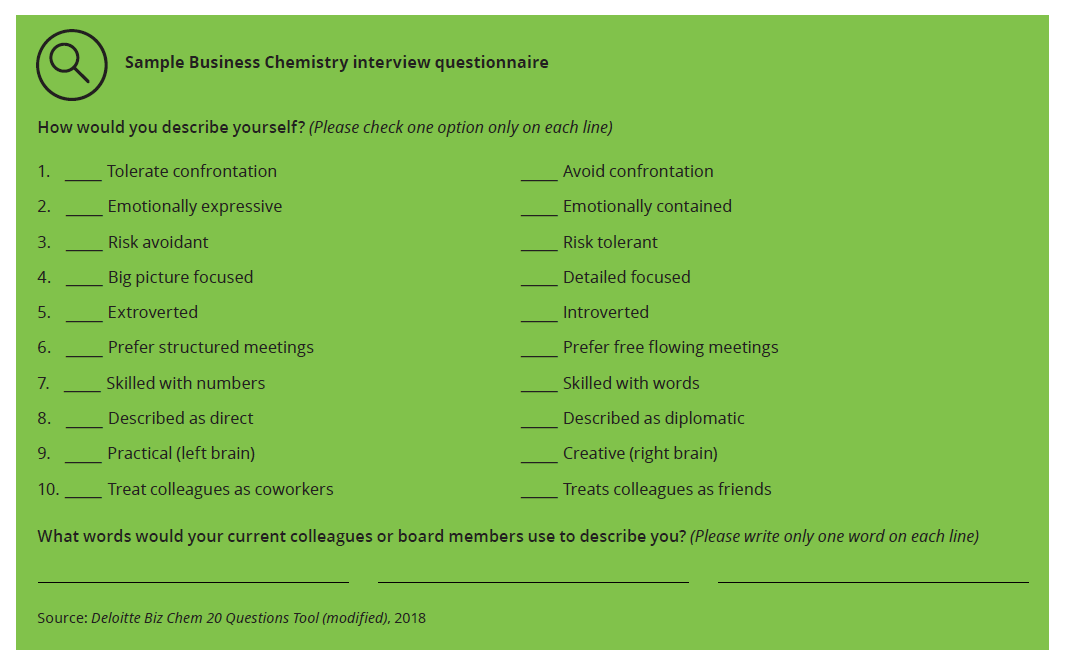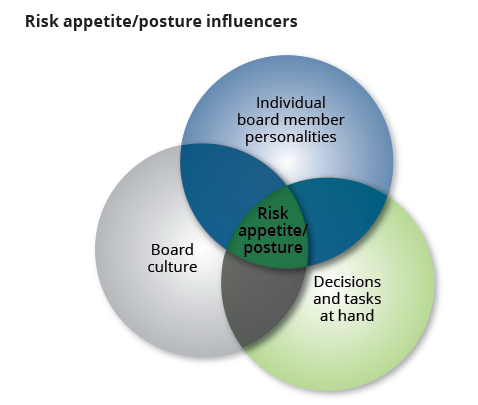Fuente: Harvard Law School Forum on Corporate Governance and Financial Regulation
Autor: Dannetta English Bland, Deloitte LLP
Introduction
The average board member spends about 245 hours on board matters over the course of a year, according to the 2018-2019 NACD Public Company Governance Survey. [1] However, less than one-third of this time, 74 hours, [2] consists of board member interactions, such as telephonic and in-person board and committee meetings and a handful of board dinners. [3] Given these limited interactions, how well do board members actually know one another? Do they appreciate why some like to listen to the facts before commenting or why some comment before facts have been shared? Do they know why some board members lean in more heavily on details, while others seem to be exclusively focused on big picture matters? Do they understand why some members of management just do not click with the board, or why some directors don’t seem to get along?
Business Chemistry may help to answer the above questions and many others, and can play a fundamental role in understanding how the board works—or does not work—both internally and in its interactions with management. Business Chemistry is relevant for and can impact such wide-ranging matters as the composition of the board and its committees, the board’s risk posture, decision making, potential biases, and friction points. In other words, a board’s Business Chemistry can greatly affect its effectiveness and have an impact on the performance of the company.
What is Business Chemistry?
Business Chemistry is an analytics-driven tool for understanding and leveraging differences between people. It has been used by hundreds of thousands of professionals around the world to build healthier teams, enhance customer engagement, and make board members, and other leaders more effective in their interactions. [4] Business Chemistry, in some ways, is similar to personality assessments designed to facilitate a better understanding of personal preferences and partialities; however, Business Chemistry takes the concept further. For example, it is focused on interaction rather than introspection. It can facilitate improved effectiveness of interactions in a business setting, in addition to understanding one’s own strengths and weaknesses. Business Chemistry is also driven by data and rooted in science for credibility and reliability.
Business Chemistry for boards delves into four components:
- Understanding oneself—Identifying personal predilections and potential pitfalls
- Understanding others—Identifying what to look for to develop insights about others through observation
- Adapting one’s style—Exploring ways to engage more effectively with management and fellow board members
- Reflection—Exploring implications of board composition on activities such as decision making, risk posture,
How could Business Chemistry types show up in the boardroom?
Through Deloitte’s extensive research, it was concluded that there are four distinctive behaviors classified as Business Chemistry types:
Pioneers, Guardians, Drivers, and Integrators. These “types” can be identified through a number of processes such as observation, interviews and questionnaires, hypothesis exercises (also known as hunching), or Deloitte’s Business Chemistry online assessment tool.
It is important to note that everyone is a mix of all four Business Chemistry types; however, a majority of the population is characterized by two—a primary and secondary style. Most can flex between their primary and secondary types as the environment, situation or conversation may deem necessary. Though it’s important to identify and understand one’s Business Chemistry type and its defining characteristics, it is equally important to understand the positive and negative perceptions that go along with each type, based on people’s working experiences with each. Let’s explore the four types:
Pioneers value possibilities. They are known for sparking energy, being outgoing, spontaneous and adaptable. Pioneers are creative thinkers who see the big picture and believe that with big risk come big rewards. How could Pioneers show up in the boardroom? Pioneers love to brainstorm big ideas. They are known for speaking up and making decision quickly; however, they are not known for thinking through all the execution details before sharing ideas widely which at times can add significantly to management’s workload. Pioneers can be an asset to the board when discussing a company’s long-term strategy and innovation concepts.
Guardians value stability. They are known for bringing order and rigor to the boardroom. Guardians are practical, detailed oriented and deliberate in decision making. They tend to stick with the status quo and can be a bit risk averse. How could Guardians show up in the boardroom? Guardians typically present themselves as reserved and calm, as they like to listen and collect the facts prior to presenting an opinion. They appreciate a large amount of information before making a decision but at times can get stuck in the weeds. Guardians can be extremely useful in the boardroom due to their attention to concrete detail and love of data.
Drivers value challenge. They are known for being direct in their approach to people and problems. Drivers are technical, quantitative, logical and skilled at identifying patterns to understand things. How could Drivers show up in the boardroom? Drivers typically are tough-minded and ask the hard, to the point-of-the-matter, questions. They are not afraid to ruffle the feathers of other board members or members of management. Drivers are focused on the end goals and can be often seen as leaders in the boardroom. Drivers can be resourceful and insightful in technical discussions brought to the board, as they are skillful at understanding complexities and simplifying through logic, but can come across as abrasive if others do not catch on as quickly.
Integrators value connections. They are known for being the “glue” that holds the boardroom together, especially during chaotic times. Integrators are empathic, diplomatic, non-confrontational and consensus oriented. How could Integrators show up in the boardroom? Integrators are well networked and often have connections that are useful for management and the board. Integrators can be a good resource on a nominating and governance committee, human resources and personnel issues, and the oversight of the new board member orientation processes due to their interpersonal skills, love of people, and vast network/connections. Integrators can be very helpful as committee members but at times struggle to make a decision due to their open-mindedness and passion for comradery.
There are benefits to having a balance of all four Business Chemistry types on a given board. The types evolve together, and while the differences between them may cause conflict when misunderstood, having different behavioral types may also strengthen the culture of the boardroom when working altogether.
How can Business Chemistry influence board composition?
Board composition has been and remains the subject of intense focus by institutional investors, regulators, and other corporate stakeholders. One critical aspect of board composition is diversity, or the lack of it. According to the Board Practices Report, [5] published in 2019 by Deloitte and the Society for Corporate Governance, 94% of survey respondents said their boards are looking to increase board diversity. The traditional diversity boardroom dialogue has been through the lens of gender and race/ethnicity; however, it has expanded to include considerations for skillsets, experience, and cognitive diversity.
Cognitive diversity can bring an organization at least three key benefits. Diverse thinkers help:
- Guard against groupthink and expert overconfidence,
- Increase the depth and scale of new insights, and
- Identify individuals who can best tackle their most pressing problems. [6]
Identifying one’s own Business Chemistry type, as well as those of other board members or members of management, may lead to more efficient and effective interactions between the board and management. The data from Business Chemistry show that the c-suite tends to skew towards Pioneers and Drivers and that when finance or audit committees are involved, there may be a skewing toward Guardians and Drivers. However, it is inadvisable to assume that because someone is a CFO or an audit committee member, he or she must be a certain type; the data does not support that. The data suggest that all types can effectively execute in these roles, but there are more Guardians and Drivers who relate to data and/or logical processing than in an average population.
Board composition is not susceptible to a one-size-fits-all approach. It reflects a mix of skills, experience, and diversity, in all forms, each of which has its own complexities. In addition, board composition is never a completed project; it requires ongoing focus, monitoring, and attention, as both the directors’ attributes and the company’s needs change over time. Through the use of Business Chemistry, the board’s composition and its related gaps can be identified.
The board interview process can be instrumental in identifying candidates to fill those gaps. Some boards have moved to asking the candidate to fill out an interview questionnaire with questions that can help identify their Business Chemistry type. (See “Sample Business Chemistry interview questionnaire.”) Focusing on Business Chemistry can help a board, and the individual board members, to be greater than the sum of its parts.
Using science to improve board effectiveness
While it’s natural to think of working styles in the context of one’s own predilections and tendencies, the reality is that very few people operate truly independently. Success in the boardroom often hinges on being able to navigate behavioral dynamics, in which board members, each with his or her own unique traits, interact with each other in a multidimensional way.
Business Chemistry seeks to harness the complementary potential of different working styles, but this doesn’t always happen naturally. So how can boards get there? Business Chemistry can help boards address four key questions:
- First, what is the Business Chemistry composition of the individuals on the board and on the committees?
- Second, what is the culture of the collective board and/or the broader organization?
- Third, how can that composition be utilized to promote successful board coordination and achieve the organization’s collective goals for the task at hand?
- Fourth, how does board composition effect the board’s risk appetite/posture and decisions/tasks?
- Pioneer—Show excitement in an idea or concept by bringing interest and conviction; keep things moving quickly, as Pioneers tend to think and speak rapidly, and can be prone to boredom; develop high level/strategic materials—the less detail, the better; and lastly, be careful not to let a Pioneer’s big ideas and willingness to go off topic takeaway from the purpose.As board members begin to understand their own styles and the communication preferences of others, the interaction and style of board and committee meetings may shift as the group learns how to operate more effectively together. When engaging others, consider a few “rules of engagement” for each Business Chemistry type, to benefit interactions among members of the board, committees, and management:
- Guardian—Provide data in advance of the meeting; respect the agenda by being punctual, stating the objective(s) and staying on task; cite sources and make ideas logical and practical; give adequate time to allow for the processing of information; and lastly, be prepared, but, be careful not to let a Guardian’s affinity for details get the topic stuck in the weeds.
- Driver—Structure the meeting backwards—start with the conclusion and provide facts to support it; build a logical argument and get the facts straight; assert a point of view; avoid excessive small talk and pomp and circumstance; anticipate pushback; and lastly, be smart, be quick and, don’t let a Driver’s challenging nature be intimidating.
- Integrator—Engage in small talk prior to the start of the meeting; structure the meeting to be collaborative in format; begin with the big picture and purpose; be friendly; ask questions, listen actively; do not rush; be open to alternatives; and lastly, use stories to express ideas to bring an Integrator along on the journey but do not leave the conversation without firmly knowing where they stand as Integrators may not be as forthright with their Make it a point to ask for, and really hear, their thoughts.
Conclusion—Building a more effective board
Business Chemistry is not just about how you can be more effective in one-on-one interactions with fellow board members; it is also about getting the best out of committees and boards, and how to draw out the strengths and minimize less desirable traits within each group or the environment. Applying both modern skills matrices and frameworks like Business Chemistry may help create higher-performing boards and committees. Implementing a few of the basic philosophies of Business Chemistry may also allow for additional opportunities for the board to be leveraged as the strategic asset that it should be to management and the company’s shareholders. Continuing to provide opportunities for board members to connect and interact are essential. When directors have knowledge of each other’s communication styles and an understanding of how to engage more effectively, trust and collegiality are likely to build, creating a more effective board experience.
Endnotes
12018–2019 NACD Public Company Governance Survey; National Association of Corporate Directors, December 8, 2019.(go back)
22018–2019 NACD Public Company Governance Survey; National Association of Corporate Directors, December 8, 2019.(go back)
3Board Practices Report: Common threads across boardrooms; Deloitte LLP Center for Board Effectiveness and the Society of Corporate Governance; 2019.(go back)
4Business Chemistry: Practical Magic for Crafting Powerful Work Relationships by Kim Christfort, Suzanne Vickberg; 2018(go back)
5Board Practices Report: Common threads across boardrooms; Deloitte LLP Center for Board Effectiveness and the Society of Corporate Governance; 2019(go back)
6Diversity’s new frontier—Diversity of thought and the future of the workforce, Deloitte LLP; 2013.(go back)














